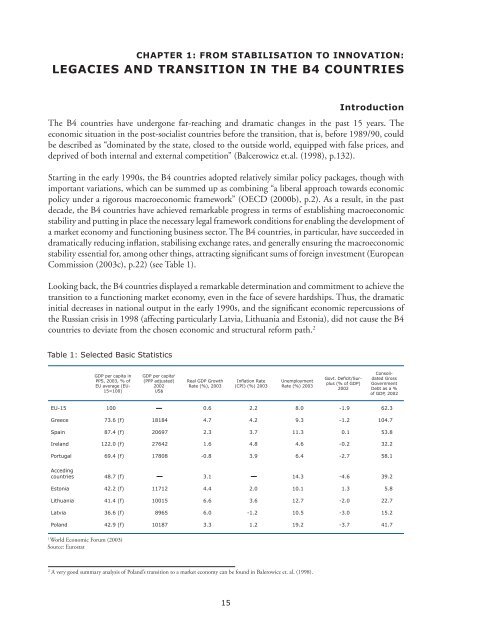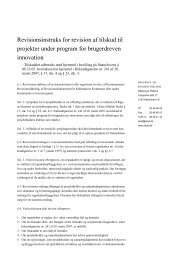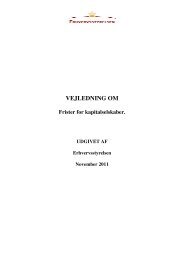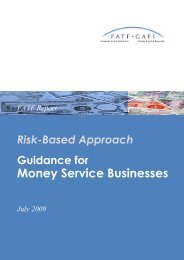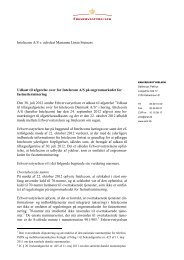Competing in the Single Market - SMEs and ... - Erhvervsstyrelsen
Competing in the Single Market - SMEs and ... - Erhvervsstyrelsen
Competing in the Single Market - SMEs and ... - Erhvervsstyrelsen
Create successful ePaper yourself
Turn your PDF publications into a flip-book with our unique Google optimized e-Paper software.
CHAPTER 1: FROM STABILISATION TO INNOVATION:LEGACIES AND TRANSITION IN THE B4 COUNTRIESIntroductionThe B4 countries have undergone far-reach<strong>in</strong>g <strong>and</strong> dramatic changes <strong>in</strong> <strong>the</strong> past 15 years. Theeconomic situation <strong>in</strong> <strong>the</strong> post-socialist countries before <strong>the</strong> transition, that is, before 1989/90, couldbe described as “dom<strong>in</strong>ated by <strong>the</strong> state, closed to <strong>the</strong> outside world, equipped with false prices, <strong>and</strong>deprived of both <strong>in</strong>ternal <strong>and</strong> external competition” (Balcerowicz et.al. (1998), p.132).Start<strong>in</strong>g <strong>in</strong> <strong>the</strong> early 1990s, <strong>the</strong> B4 countries adopted relatively similar policy packages, though withimportant variations, which can be summed up as comb<strong>in</strong><strong>in</strong>g “a liberal approach towards economicpolicy under a rigorous macroeconomic framework” (OECD (2000b), p.2). As a result, <strong>in</strong> <strong>the</strong> pastdecade, <strong>the</strong> B4 countries have achieved remarkable progress <strong>in</strong> terms of establish<strong>in</strong>g macroeconomicstability <strong>and</strong> putt<strong>in</strong>g <strong>in</strong> place <strong>the</strong> necessary legal framework conditions for enabl<strong>in</strong>g <strong>the</strong> development ofa market economy <strong>and</strong> function<strong>in</strong>g bus<strong>in</strong>ess sector. The B4 countries, <strong>in</strong> particular, have succeeded <strong>in</strong>dramatically reduc<strong>in</strong>g <strong>in</strong>flation, stabilis<strong>in</strong>g exchange rates, <strong>and</strong> generally ensur<strong>in</strong>g <strong>the</strong> macroeconomicstability essential for, among o<strong>the</strong>r th<strong>in</strong>gs, attract<strong>in</strong>g significant sums of foreign <strong>in</strong>vestment (EuropeanCommission (2003c), p.22) (see Table 1).Look<strong>in</strong>g back, <strong>the</strong> B4 countries displayed a remarkable determ<strong>in</strong>ation <strong>and</strong> commitment to achieve <strong>the</strong>transition to a function<strong>in</strong>g market economy, even <strong>in</strong> <strong>the</strong> face of severe hardships. Thus, <strong>the</strong> dramatic<strong>in</strong>itial decreases <strong>in</strong> national output <strong>in</strong> <strong>the</strong> early 1990s, <strong>and</strong> <strong>the</strong> significant economic repercussions of<strong>the</strong> Russian crisis <strong>in</strong> 1998 (affect<strong>in</strong>g particularly Latvia, Lithuania <strong>and</strong> Estonia), did not cause <strong>the</strong> B4countries to deviate from <strong>the</strong> chosen economic <strong>and</strong> structural reform path. 2Table 1: Selected Basic StatisticsGDP per capita <strong>in</strong>PPS, 2003, % ofEU average (EU-15=100)GDP per capita 1(PPP adjusted)2002US$Real GDP GrowthRate (%), 2003Inflation Rate(CPI) (%) 2003UnemploymentRate (%) 2003Govt. Deficit/Surplus(% of GDP)2002ConsolidatedGrossGovernmentDebt as a %of GDP, 2002EU-15 100 0.6 2.2 8.0 -1.9 62.3Greece 73.6 (f) 18184 4.7 4.2 9.3 -1.2 104.7Spa<strong>in</strong> 87.4 (f) 20697 2.3 3.7 11.3 0.1 53.8Irel<strong>and</strong> 122.0 (f) 27642 1.6 4.8 4.6 -0.2 32.2Portugal 69.4 (f) 17808 -0.8 3.9 6.4 -2.7 58.1Acced<strong>in</strong>gcountries 48.7 (f) 3.1 14.3 -4.6 39.2Estonia 42.2 (f) 11712 4.4 2.0 10.1 1.3 5.8Lithuania 41.4 (f) 10015 6.6 3.6 12.7 -2.0 22.7Latvia 36.6 (f) 8965 6.0 -1.2 10.5 -3.0 15.2Pol<strong>and</strong> 42.9 (f) 10187 3.3 1.2 19.2 -3.7 41.71World Economic Forum (2003)Source: Eurostat2A very good summary analysis of Pol<strong>and</strong>’s transition to a market economy can be found <strong>in</strong> Balerowicz et. al. (1998).15


